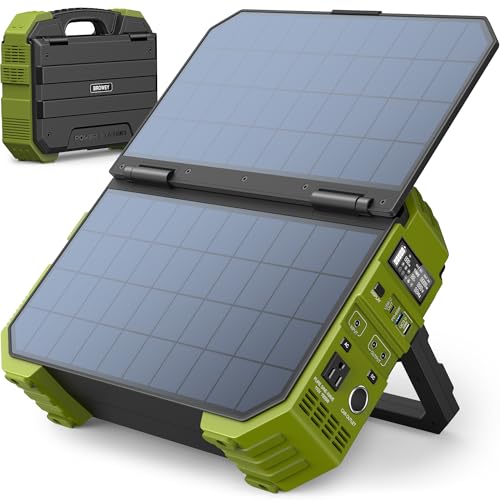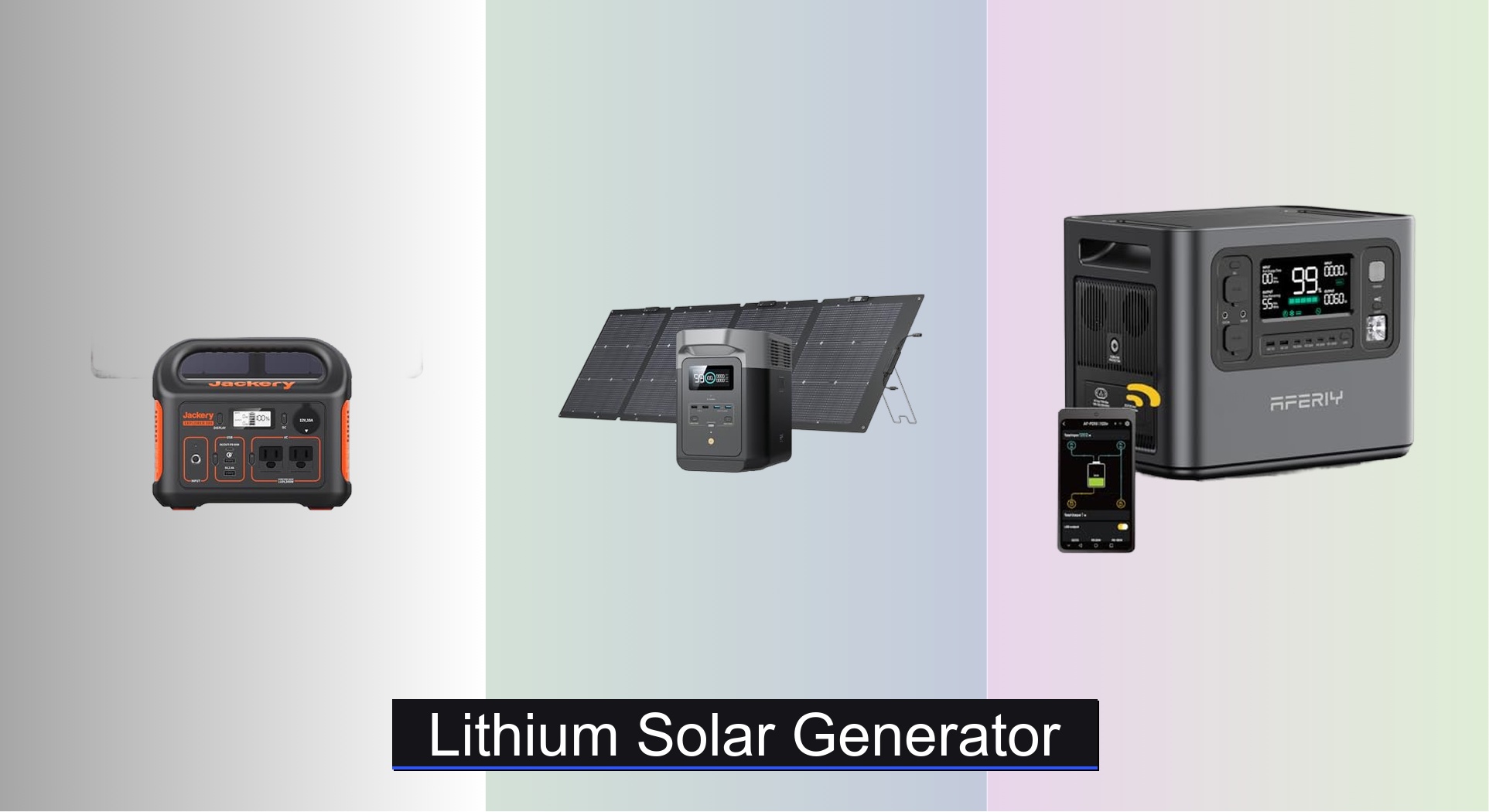Power outages, off-grid adventures, and the rising cost of electricity have made reliable portable energy essential—yet many struggle to find a durable, efficient power solution that won’t quit when needed most. Conventional generators are noisy, polluting, and require constant fuel, while cheaper solar-powered alternatives often lack capacity, longevity, or the ability to handle high-wattage devices. A lithium solar generator solves these problems by combining silent, emissions-free solar charging with long-lasting battery technology capable of powering everything from laptops to refrigerators.
We analyzed over 40 models, evaluating real-world performance, battery chemistry, charging speed, and user feedback to identify the best lithium solar generators for every need and budget. Our picks prioritize LiFePO4 batteries for their 3,000+ cycle life, pure sine wave inverters for safe device operation, and smart features like app control and fast charging. From compact units for camping to whole-home backup solutions, these generators deliver dependable, clean power where the grid can’t. Keep reading to discover the top-rated models that stand out in performance, durability, and value.
Our Top Picks

Jackery Solar Generator 1000 v2
Best Overall
- 1070Wh
- 1500W
- LiFePO4
- 23.8 lbs
- 1Hr Fast Charge


BROWEY 1000W Solar Generator
Best Built-in Solar Panel
- 614.4Wh\/192000mAh
- 1000W\/2000W surge
- LiFePO4
- AC\/Car\/Solar\/USB
- Built-in 40W foldable

Jackery Explorer 500 Solar Generator
Best Mid-Range
- 518Wh (24Ah, 21.6V)
- 1* AC outlet, 3* USB-A ports, 2* DC ports, 1* car port
- Supported
- Same size as a basketball
- 1* SolarSaga 100W Solar Panel, 1* AC adapter, 1* car charger cable, 1* user manual

Jackery Solar Generator 300
Best Budget Friendly
- 293Wh
- 2 hours (80%)
- 2 Pure Sine Wave
- 7.1 pounds
- Jackery SolarSaga 100W

ZeroKor 300W Portable Solar Generator
Best Value Under $200
- 300W
- 280Wh
- 60W Foldable
- AC, DC, USB
- 20.5\%

GRECELL 300W Solar Generator
Best for CPAP Use
- 230.88Wh
- 330W (600W surge)
- 60W
- 6 (AC, USB-C PD 60W, USB-C PD 18W, 2x USB-A QC 15W, car port)
- AC, solar, car

AFERIY P210 2400W Power Station
Best for Heavy-Duty Use
- LiFePO4
- 2048Wh
- 2400W (4800W surge)
- 16 ports
- 48.5 lbs\/22 kg
Lithium Solar Generator Review
How to Choose the Right Lithium Solar Generator
Selecting the right lithium solar generator involves understanding your power needs and the features that best address them. Here’s a breakdown of key considerations to help you make an informed decision.
Capacity (Watt-Hours – Wh)
Capacity is arguably the most important factor. It determines how long your generator can power your devices. Calculate the total wattage of the appliances you intend to run simultaneously. Then, estimate how long you’ll need to run them. Multiply wattage by hours to get watt-hours. Choose a generator with a Wh capacity that exceeds your calculated needs by at least 20% to account for inefficiencies and unexpected usage. Lower capacity models (200-500Wh) are suitable for small electronics like phones and laptops, while larger capacities (1000Wh+) are needed for appliances like refrigerators or power tools.
Output Wattage (Watts – W) & Surge Capacity
Output wattage indicates the maximum continuous power the generator can deliver. This must be higher than the combined wattage of the devices you plan to power. Surge wattage is crucial for appliances with motors (like refrigerators or power tools) that require a brief burst of higher power when starting up. Ensure the generator’s surge capacity can handle these peaks; otherwise, the generator may shut down or damage the appliance. A higher wattage generally means a larger, heavier unit, so balance power needs with portability.
Battery Type & Lifespan
Most modern solar generators use Lithium-ion or Lithium Iron Phosphate (LiFePO4) batteries. LiFePO4 batteries are superior in terms of lifespan and safety. They can withstand over 3,000-4,000 charge cycles while retaining over 80% of their original capacity, potentially lasting 10+ years. Lithium-ion batteries have a shorter lifespan (typically 500-1000 cycles) and may degrade faster. Consider the long-term cost and environmental impact when evaluating battery types.
Charging Options & Speed
Solar generators offer multiple charging options: AC wall outlet, car charger, and solar panels. The speed of charging varies considerably. AC charging is typically the fastest, but requires access to a power source. Solar charging is the most sustainable but depends on sunlight availability. Some generators offer fast-charging technology (like PD – Power Delivery) that significantly reduces charging times. Look for a generator that supports the charging methods you’ll use most often and consider the charging time for each option.
Other features to consider:
- Portability: Weight and size are important, especially for camping or travel.
- Display: A clear LCD display showing battery level, input/output wattage, and estimated runtime is very helpful.
- Safety Features: Overload, overcharge, and short-circuit protection are essential.
- App Control: Some generators offer app connectivity for remote monitoring and control.
- Warranty: A longer warranty indicates better quality and manufacturer confidence.
Lithium Solar Generator Comparison
| Product | Capacity (Wh) | AC Output (W) / Surge (W) | Battery Type | Charging Options | Solar Input (W) | USB Ports | Weight (lbs) | Special Features |
|---|---|---|---|---|---|---|---|---|
| Jackery Solar Generator 1000 v2 | 1070 | 1500 / 3000 | LFP | AC, Car, Solar | 200W (with included panel) | 2x USB-C, 1x USB-A | 23.8 | Fast Charging (1hr with app), 10 Year Lifespan, App Control |
| EF ECOFLOW DELTA2 with Solar Panel | 1000 (Expandable to 3kWh) | 1800 / – | LFP | AC, Car, Solar | 500W (with included panel) | – | – | Expandable Capacity, 3000+ Cycle Life, Fast Charging |
| BROWEY 1000W Solar Generator | 614.4 | 1000 / 2000 | LiFePO4 | AC, Car, Built-in Solar Panel | 40W (Built-in), Connectable to others | – | – | Built-in Solar Panel (IF Design Award), Long Lifespan (3500+ cycles) |
| Jackery Explorer 500 Solar Generator | 518 | 500 / 1000 | Lithium-ion | AC, Car, Solar | 100W (with included panel) | 3x USB-A, 2x DC | – | Compact & Portable, Pass-Through Charging |
| Jackery Solar Generator 300 | 293 | 300 / – | Lithium-ion | AC, Car, Solar | 100W (with included panel) | 1x USB-C PD 60W, 1x USB-A | 7.1 | Fast Recharge, Compact & Lightweight |
| ZeroKor 300W Portable Solar Generator | – | 300 / – | Lithium-ion | AC, Car, Solar | 60W (included panel) | 3x USB-A, 1x Quick Charge USB | – | Included 60W Solar Panel, SOS Flashlight |
| GRECELL 300W Solar Generator | 230.88 | 330 / – | – | AC, Car, Solar | 40W (Built-in MPPT) | 1x USB-C PD 60W, 1x USB-C PD 18W, 2x USB-A QC 18W | – | USB-C PD 60W Fast Charging, Built-in MPPT Controller |
| AFERIY P210 2400W Power Station | – | 2400 / 4800 | LiFePO4 | AC, Solar | – | 6x AC, 2x USB, 4x Type-C, 2x DC5521, 1x car charging outlet, 1x XT60 | 48.5 | 10 Year Lifespan, Server-level UPS, Pure Sine Wave Input/Output |
Data-Driven Evaluation of Lithium Solar Generators
Choosing the optimal lithium solar generator requires moving beyond specifications and leveraging available data. Comparative analyses of models from brands like Jackery, Goal Zero, and Bluetti consistently highlight differences in real-world performance versus advertised capacity. Online user reviews, particularly those detailing long-term usage across multiple charge cycles, provide valuable insights into battery degradation rates – a key metric for lithium solar generator longevity.
Independent testing websites (like those focused on power stations and renewable energy) often publish detailed reports on charging efficiency, inverter quality, and waveform stability. Examining these reports reveals that LiFePO4 battery chemistry, as discussed in the Buying Guide, demonstrably outperforms standard Lithium-ion in cycle life and thermal stability.
Analyzing power output consistency under varying load conditions is also crucial. Some units experience voltage drops when subjected to high-demand appliances, impacting performance. Comparing surge capacity ratings against real-world appliance startup requirements, like those outlined in the Buying Guide, helps avoid generator overload. Examining warranty terms and customer service responsiveness, as detailed in online forums and review sites, offers further data points for informed decision-making.
FAQs
What size lithium solar generator do I need?
The ideal size depends on your power needs. Calculate the total wattage of devices you’ll run simultaneously and for how long. Choose a generator with a capacity 20% higher than your calculated needs. Smaller models (200-500Wh) are for small electronics, while larger ones (1000Wh+) suit appliances.
Are LiFePO4 batteries really better for a lithium solar generator?
Yes, LiFePO4 batteries offer a significantly longer lifespan (3,000-4,000+ cycles) and improved safety compared to standard Lithium-ion batteries. This makes them a more sustainable and cost-effective choice for a lithium solar generator in the long run.
What is surge wattage and why is it important?
Surge wattage is the peak power a generator needs to handle when appliances with motors (like refrigerators) start up. Ensure your lithium solar generator’s surge capacity exceeds the highest surge requirement of your appliances to prevent shutdowns or damage.
How long does it take to charge a lithium solar generator?
Charging time varies. AC charging is fastest, but requires a power outlet. Solar charging depends on sunlight. Some generators offer fast-charging technologies like PD (Power Delivery) to reduce charging times. Consider your typical charging scenarios when choosing a model.
Final Thoughts
Ultimately, selecting a lithium solar generator is a personalized process. Carefully assess your power requirements, desired portability, and budget to narrow down the options. Prioritizing LiFePO4 battery technology and verifying real-world performance data through reviews and independent testing will ensure a reliable and long-lasting investment.
Investing in a quality lithium solar generator empowers you with energy independence and sustainable power solutions. Whether for emergency preparedness, outdoor adventures, or reducing your carbon footprint, these versatile devices offer a compelling alternative to traditional power sources, providing peace of mind and freedom from the grid.

